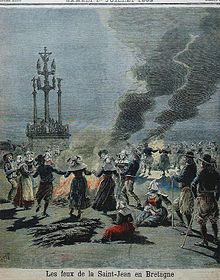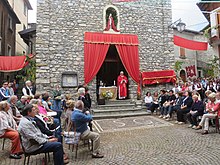Bisperas ni San Juan

| St. John's Eve Eve of the Feast of Saint John the Baptist | |
|---|---|
| St. John's Eve Eve of the Feast of Saint John the Baptist | |
| Opisyal na pangaran | Saint John's Eve |
| Inaapod man na | Eve of the Feast of Saint John the Baptist |
| Pigseselebrar kan | Roman Catholic Church Lutheran Churches Anglican Communion |
| Klase | Christian, Cultural |
| Importansya | The eve of Saint John's Day, which celebrates the Nativity of Saint John the Baptist |
| Katapusan | 24 June |
| Petsa | 23 June |
| Mga selebrasyon | Fireworks, Saint John's bonfires, visiting streams and rivers, watching theatrical dramas related to the life of Saint John the Baptist, and family gatherings |
| Mga pag-obserba | Church services, processions, collecting special plants (e.g. Saint John's wort) and having them blessed by a priest/minister |
| Nasusugpon sa | Nativity of Saint John the Baptist |
An Bisperas ni Santo Juan o San Juan, poon sa pagsolnop nin saldang kan 23 Hunyo, iyo an bisperas kan aldaw nin pista ni Santo Juan Bautista. saro sa kadikiton na aldaw nin kapiyestahan na tanda kan pagkamundag nin sarong santo, imbes na an saindang kagadanan. Ebanghelyo ni Lucas (Lucas 1:26-37, 56-77) nagsasabi na si Juan namundag anom na bulan bago ki Jesus; kun siring, an kapistahan ni Juan Bautista itinakod sa 24 Hunyo, anom na bulan antes kan Navidad. Romanong kalendaryo, 24 Hunyo an petsa kan solsticio sa tig summer solstice" asin si Bisperas ni San Juan konektadong marhay sa mga kaorogmahan sa Midsummer sa Europa. mga tradisyon kaagid kan sa Aldaw nin Mayo asin kaiba an mga bonfires (mga kalayo ni Juan), bangkete, prosisyon, serbisyo sa simbahan, asin pagtipon nin layas na mga tinanom.
Hinalean
[baguhon | baguhon an source]


Aldaw nin kapiyestahan ni Santo Juan Bautista, inestablisar kan dai nababangang Kristiyanong Simbahan sa ika-1 siglo A.D., bilang pagtaong onra sa pagkamundag ni San Juan Baptist, na nakarekord sa Biblia kan mga Kristiyano anom na bulan bago si Jesus.[1] an mga simbahan na Kristiano sa Solnopan iyo an nagin tanda kan pagkamundag ni Jesus kan Disyembre 25 (Chris), an bangketeng nagtanda sa pagkamundag ni Santo Juan (Aldaw ni Juan) ibinugtak anom na bulan bago.[2]
[3]An suanoy na Romanong kinaban, 24 Hunyo an tradisyonal na petsa kan solstice sa tig - init asin 25 Disyembre an petsang winter solstice,[4] na parehong tinandaan nin mga kapiestahan.[5]
Sa Filipinas
[baguhon | baguhon an source]Sa Filipinas, an kapiyestahan sarong selebrasyon nin pagpasalamat na ginigibo sa tradisyonal na "barasaan" o pagdono'not kan tubig sa mga aki asin darakula-dakula sa mga tinampo bilang paagi nin paghiras kan mga bendisyon. de, an kompetisyon sa pagbayle asin iba pang aktibidad nag - agi kan taonan na selebrasyon.
Hilingon pa
[baguhon | baguhon an source]Toltolan
[baguhon | baguhon an source]- ↑ Fleteren, Frederick Van; Schnaubelt, Joseph C. (2001). Augustine: Biblical Exegete (in English). Peter Lang. p. 197. ISBN 9780820422923.
The cult of John the Baptist began to develop in the first half of the fourth century. Augustine is the first witness to a feast of the birth of John the Baptist, which was celebrated on June 24.
- ↑ Hill, Christopher (2003). Holidays and Holy Nights: Celebrating Twelve Seasonal Festivals of the Christian Year (in English). Quest Books. p. 163. ISBN 9780835608107.
- ↑ Billington, Sandra (2002). The Concept of the Goddess. Routledge. p. 134.
- ↑ O'Neill, William Matthew (1976). Time and the Calendars. Manchester University Press. p. 85.
- ↑ Forsythe, Gary (2012). Time in Roman Religion: One Thousand Years of Religious History. Routledge. pp. 123, 182.
Varro places the equinoxes and solstices at the midpoints of the seasons ... His dating for the beginnings of the four seasons are as follows: February 7 for spring, May 9 for summer, August 11 for autumn, and November 10 for winter.
